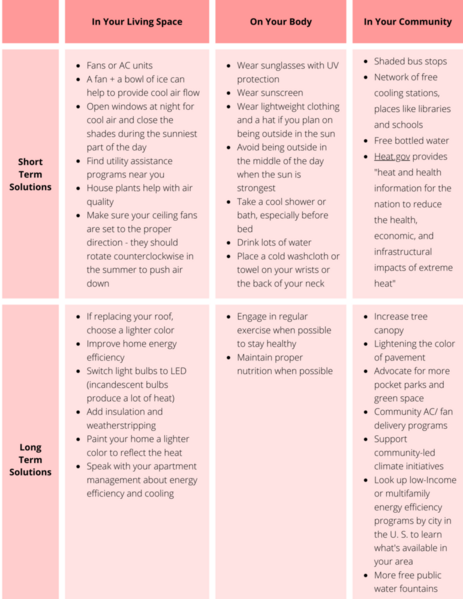In order to create resilient and thriving communities, we must address the threat that climate change and temperature increases cause. The global climate emergency continues to generate individual, community, and societal distress and traumas that compound historical traumas.
This is a follow up to my last article, Heat as an ACE & what rising temperatures mean for us. Here, I have tried to compile a list of resources and ideas with varying levels of cost and complexity that anyone can use, However, in some cases, there may be financial or other limitations to implementing the solutions.
There are a number of things we can all do to protect ourselves from extreme heat and its accompanying stress -- on your street, in your neighborhood, and at the local and federal government levels. Some of these steps will help with the immediate needs caused by increased heat from climate change and others are long-term measures that will better protect our communities in the future.
There are day-to-day things that we can all do to protect ourselves as individuals – see the list below. But I also encourage you to get involved in your local government and vote for politicians who care about climate action for long-term, sustainable solutions. You may have heard about the Inflation Reduction Act, recently signed into law, which includes Congress’s largest investment ever in fighting climate change. We must all use and spread these strategies to protect ourselves and our children from the traumatic effects of heat.
Day-to-day ways to stay cool:
- Stay up to date on your local weather; be prepared for upcoming heat waves
- Drink extra water and healthy fluids
- Avoid dark colored clothing
- Protect your skin from the sun with long sleeves, hats, and sunscreen
- Seek shade when spending periods of time outside
- Wear sunglasses with UV protection
- Avoid spending long periods of time in direct sun
- Set up a fan over a bucket of ice or turn on your air conditioner if you have one
Preparing yourselves, your family, and your community for increasing temperatures is a long-term project. Although some ways to heat-proof your home can be expensive, there are many utilities assistance programs available here in the United States, on both a federal and a state level. To find local utilities assistance programs near you, search online for “your community” + “local utilities assistance program.” Federally, the Low Income Home Energy Assistance Program assists qualifying households with their home energy bills.
If you own a home, when it’s time to replace your roof, choosing a lighter color will help to keep your home cool and decrease the need to run your fans and air conditioning. Homeowners may also be able to take advantage of home energy improvement loans to make updates to their homes like checking for proper insulation and installing energy-efficient lighting. In the United States, the Department of Energy offers a Weatherization Assistance Program which helps homeowners reduce their energy costs and increase the energy efficiency of their homes. In addition to reducing your electricity usage and keeping your home cooler, these can also help to save homeowners money in the long term.
If you don’t own your home, there are still plenty of things you can do to keep your living space cool in a heat wave:
- Close your blinds or draw your shades during the hottest part of the day
- If you have double-hung windows, make sure to open the bottom and top parts of the window for proper air flow and ventilation
- If you don’t have air conditioners, place a fan over a bucket or bowl of ice
- When preparing meals in the summer, try to avoid turning on the stove or oven
- Putting your sheets or a small blanket in the freezer and then bringing them to bed with you can cool down your sleeping area
On a community level, we can all advocate for adopting policies and practices that include heat-resilient solutions. Community advocacy is an important and powerful tool to protect our friends, families, neighbors, and future generations.
- Search for climate groups that already exist in your area. The environmental protection movement is not new and joining existing groups is a way to continue work already being done
- Read your local paper and scan for environmental topics
- Learn about environmental justice issues specific to your area
- Turn your advocacy into a habit
- Get in touch with your local representative or other government official to learn their stance on climate change and what they are doing to protect your community
Summer heat can be exhausting and seem never-ending. It can be really stressful to try to find a cool place to spend time, especially without also spending money. Heat can have serious impacts on your health -- heatstroke, heat exhaustion and heat-related hives are all common symptoms of excess heat exposure. If you notice these signs or symptoms in yourself or someone you know, please seek medical attention. In the United States, excessive heat causes more deaths than hurricanes, flooding and tornadoes combined.
On the bright side, scientists, community advocates, and impassioned youth are researching, brainstorming, and creating new solutions every single day. Things like cooling centers and “cool roofs” are all relatively new solutions to combat the heat associated with climate change.
Please comment below with any additional tips or tricks you may have to stay cool.
Interested in learning more about environmental justice and PACEs? You can sign up for PACEs Connection's free Creating Resilient Communities Accelerator Course for a complete introduction to the science of positive & adverse childhood experiences.



Comments (0)